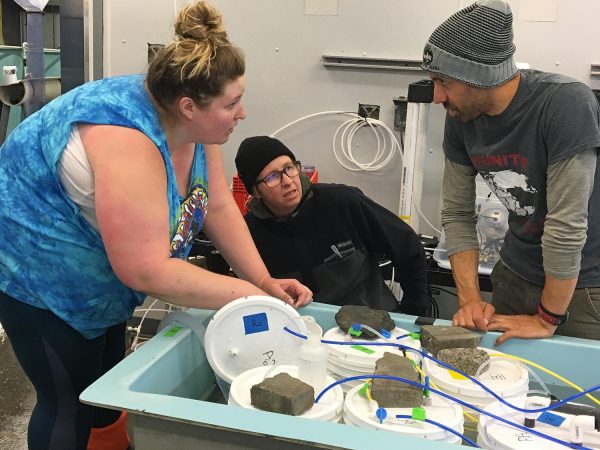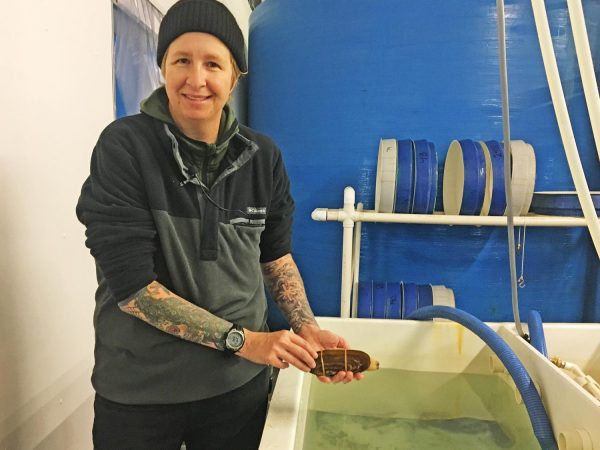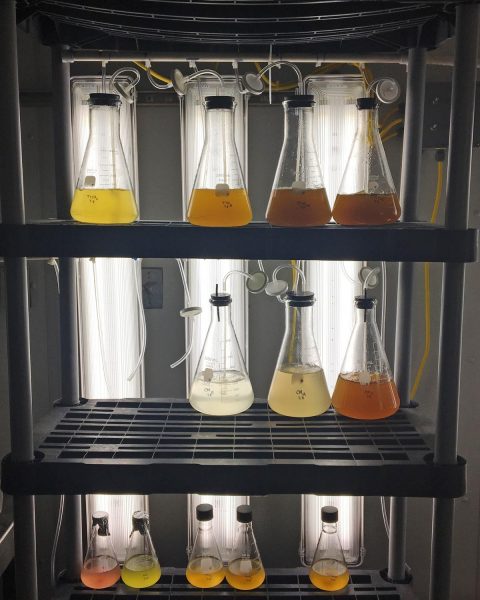Study explores decline of Cook Inlet razor clams
October 4, 2018
Paula Dobbyn
907-274-9698

Download text and photo captions here.
July Fourth in Seward, Alaska, is known for its fireworks, festivities and the grueling Mount Marathon race that draws elite athletes from around the world. But for a University of Alaska Fairbanks graduate student, the holiday took on a whole different meaning this year.
“It was the first time I was able to successfully spawn razor clams in the lab,” said Marina Washburn, who is working on her master’s degree at UAF’s College of Fisheries and Ocean Sciences. Her research is based out of Seward.
As locals and visitors watched a parade snake through downtown, Washburn stared into a bucket, her eyes wide as she observed new life forming at the bottom.
“We weren’t sure it was possible to spawn razor clams. My first attempt failed. When they finally hatched, I felt I could celebrate,” she said.
Washburn needed clam larvae to study how ocean acidification affects the shellfish. Razor clams have virtually disappeared on the eastern shores of Cook Inlet. Clam populations in Southcentral Alaska overall have declined since the late 1990s, according to University of Alaska researchers. It’s negatively affected people who clam for subsistence, recreation and commercial purposes.
As a fourth-generation Alaskan, Washburn grew up razor clamming on the Kenai Peninsula. But officials shut down the harvest in 2015, citing severe population declines. It has remained closed ever since.
“My family and many others have a vested interest in bringing this species back,” Washburn said.
No one knows exactly what’s caused razor clams to crash to historically low levels. Theories include “heavy surf, habitat changes, environmental stressors and predation,” according to the Alaska Department of Fish and Game. Another factor under consideration is ocean acidification, the decline of seawater pH caused by the ocean absorbing too much carbon dioxide from sources including tailpipes and smokestacks.
Washburn is testing the extent to which razor clams are resilient or susceptible to an acidifying ocean.

She’s using a method pioneered by Amanda Kelley, a marine biology assistant professor at CFOS and an ocean acidification expert. With funding from Alaska Sea Grant, Kelley developed a protocol for exposing cockles and littlenecks to varying ocean chemistry conditions that mimic not only what’s happening in the ocean today but also in future decades. Before the cockle and littleneck study, no experimental work had been done in Alaska on how native bivalves respond to ocean acidification, Kelley said.
“We’re just at the very, very beginning point of understanding how Alaska species are going to respond to OA and more broadly ocean change,” said Kelley, standing before a row of white buckets containing seawater and tiny clams with coils of plastic tubing pumping in various levels of carbon dioxide.
Under Kelley’s supervision, Washburn conducted her experiment over the course of a month this past summer at the Alutiiq Pride Shellfish Hatchery in Seward. Operated by Chugach Regional Resources Commission, an intertribal fish and wildlife nonprofit organization, the hatchery hosts some of Alaska’s most cutting-edge research on ocean acidification.
It’s important for Alaska’s food security and multibillion-dollar seafood industry to know what’s happening as ocean chemistry changes, said hatchery director Jeff Hetrick.
What is known is that the world’s oceans are becoming more acidic as the result of carbon dioxide emissions from the burning of fossil fuels. According to the National Oceanic and Atmospheric Administration, ocean acidity has increased 30 percent since the Industrial Revolution.
As the pH levels of seawater declines, species that build shells or skeletons, like clams, are having a harder time coping. Scientists say that’s because the minerals they need to construct their outer, protective layer, including calcium carbonate, become less available as seawater becomes more corrosive.
Washburn will spend the next year analyzing the physiological responses of razor clams to varying levels of acidic sea water. She’ll measure certain cellular indicators, among other things, to gauge their levels of stress and their ability to develop sturdy shells.

The research was prompted in part by oyster die-offs in the Pacific Northwest a decade ago. Scientists discovered the die-offs occurred because of low pH and a lack of calcium carbonate in the form of a mineral called aragonite. They wanted to find out if similar ocean conditions existed in Alaska where the water is colder and can hold more carbon dioxide, making it potentially more susceptible to negative effects.
Tribes and community organizations in Alaska are becoming increasingly involved in ocean chemistry research. Alaska has a growing network of villages that are collecting weekly samples of seawater and sending them to the Alutiiq Pride hatchery and to the Sitka tribe’s Southeast Alaska Tribal Ocean Research center.
Initially funded with a grant from the Bureau of Indian Affairs, the program began with eight villages in the Chugach region of Southcentral Alaska.
“We’ve expanded our program now to include communities in western and northern Alaska, places like King Cove, Utqiaġvik, Nome and Kotzebue,” said Hetrick.
Over the long term, the data will help researchers better understand how the ocean is changing and how those changes are affecting marine life. That emerging science should also help fishery managers with planning and decision-making. In a state with a $5.8 billion commercial fishery, there’s a lot at stake.
“I think we’re the canary in the coal mine,” said Jacqueline Ramsay, a shellfish biologist at Alutiiq Pride. “Polar regions are more susceptible to OA because of our colder water. To the extent that it’s going to affect our oceans, it should be a huge concern to us. Alaska is where we get our fish.”


